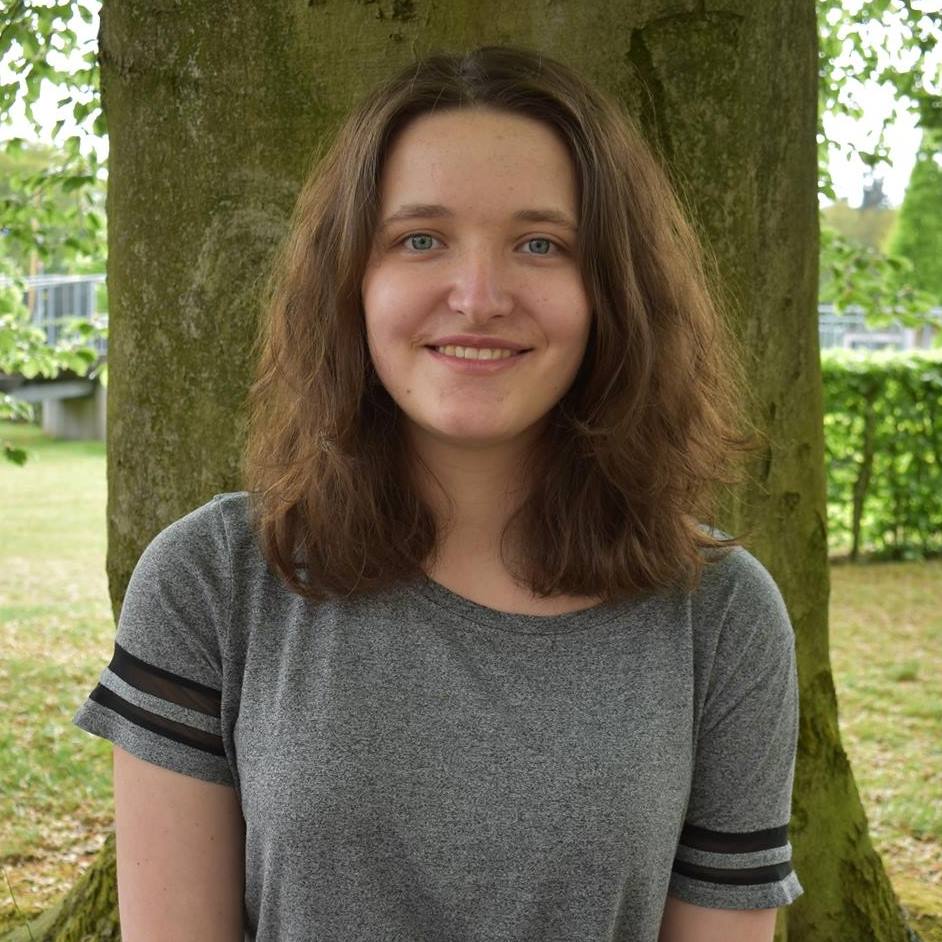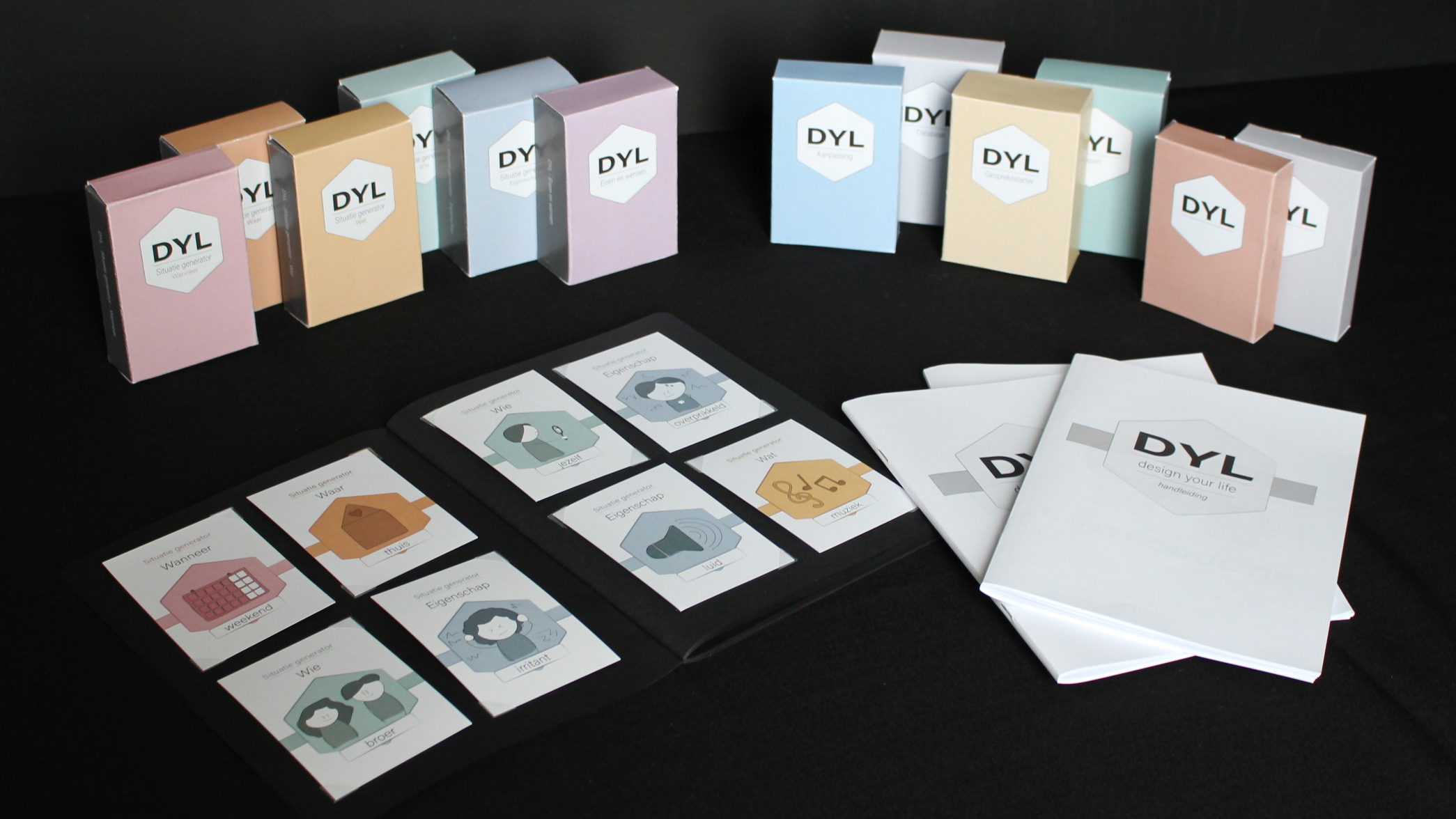Design case: Femke Wonink
Femke Wonink completed her Industrial Design Engineering MSc graduation assignment in October of 2021. Her DYL toolkit was inspired by the concept of everyday design, a form of design that emphasizes that the designing of artefacts does not end at the level of the designer, but continues at the level of the user. Her design project resulted in a toolkit consisting of multiple cardsets that guide autistic young adults (AYA) and their caregivers though a five step design process using prompts.
To be and to become an everyday designer
Take a look at the things around you. Have you ever used a chair as a stepladder or a coatrack? What reflective surfaces aside from a mirror do you use to look at yourself? What things have you used to mark a page in a book with? You’ve probably used the artefacts and physical structures (e.g. walls, windows, etc.) around you in ways that they were not originally intended for. Don’t worry, you’re not being reprimanded. It shows that you, and all people for that matter, are not only examining an artifact’s intended functionality, but also look for the potential beyond or diverge from the artifact’s original purpose (Brandes, 2008). This ability enables you to shape and reshape technologies (in the broadest sense of the word, including anything from high-tech gadgets to low-tech or no-tech products) through use in context in such a way that personal and situated needs are met. It sometimes results in using technologies differently from their intended, designed purpose (Brandes, 2008; Dourish, 2003; Wakkary & Maestri, 2008, 2007). This can range from the reinterpretation of a technology, thereby changing its semantic associations, to reinvention of technologies, thereby changing the actual structure of a designed artifact (Eglash et al., 2004). In this sense, users can be seen as everyday designers.
As part of the DYL investigation, I designed a toolkit inspired by the concept of everyday design. This had two main reasons. First, with everyday design, artefacts and structures are continually being (re)designed by the actual users according to their everchanging user needs, situations and use environments (Dix, 2007; Taylor & Swan, 2005; Wakkary & Maestri, 2007). As a result, there is an unlimited amount of possible bespoke, personalised, idiosyncratic technologies and systems within which they function. Anything can motivate the creation of an everyday design solution, including for instance personal feelings of nostalgia (Taylor & Swan, 2005), or special interests which can be a source of true pleasure and motivation for people with ASD (American Psychiatric Association, 2013). Moreover, an everyday design solution doesn’t need to be obvious or universally understood. The solution works if it is understood by the people who actually use it and they are satisfied (Taylor & Swan, 2005). Second, everyday design does not require (professional) design expertise or resources. Instead, it merely requires the everyday designer’s own expertise, namely their experiential knowledge of common artifacts and their use environments (Kim & Lee, 2014), and makes use of already existing products. This makes it suitable for a user group without a design background.

Co-designing a co-design method
This Design Your Life toolkit was created though co-design with an AYA, their mother and their professional caregivers. It is important to note that the co-designed toolkit is also a co-design method in itself. The main focus of this research is to co-design the toolkit (by AYA, caregiver and researcher) by figuring out what tools are needed for co-designing the technologies (by AYA and caregiver). This process relied on both experiential and theoretical knowledge throughout the entire toolkit design process to base (design) decisions on. This was an iterative, dynamic and inductive process using principles of grounded theory.
Toolkit design
This research resulted in a toolkit consisting of multiple card sets that guide the users through a five steps design process that uses off-the-shelf technologies as a starting point for creating personalised technology solutions.

First, being prompted by conversation starter cards, participants rediscover the products they already use in their daily lives and asks them determine why these products work for them specifically. Maybe it is their texture, size, colour or even the memory it evokes. This increases the participants’ awareness of their personal product preferences, as well as direct their attention to the possibilities that existing products have to offer.
Everyday design happens while users are in actual use situations. So in the next step, the AYA identifies, visualises and explores a use situation that is connected to a specific challenge they wish to tackle. They describe these using the prompts offered by situation generator cards. These facilitate the conversation between the AYA and their caregivers. Here, the AYA holds all the cards, literally, which provides them with the means to take control of and contribute to the conversation in a productive way without needing the caregiver as a interpreter. Consequentially, the caregiver gains insight into what the AYA thinks and feels without needing to piece this together from scratch by asking endless questions.
Lastly, the participants work to design the technology. One main challenge we faced was that the AYA was unable to envision and discuss products that did not yet exist, which is very much in line with the characteristics of ASD. That is why the toolkit asks AYAs to base their design ideas on products they already know, rather than requiring them to envision something from scratch. So they use existing everyday designs as a design resource. They already started this process in the first step of the toolkit.
Then, again with the help from prompt cards, the participants can indicate how existing solutions need to be changed to better meet the needs of the AYA. Do they need to be smaller, less noticable or more adaptable? When following through on these changes, users are everyday designing a solution that meets the use situation and challenge in question.





Main take-aways
- Everyday design is based on a user’s unique experiential knowledge of artefacts and use contexts. Making use of this knowledge results in everyday designs that are specifically suited to the personal needs, preferences and use situations of the user(s) in question. It also provides the users with something concrete to base their design ideas on. This is especially relevant people with Autism.
- Illustrated prompts on cards worked well to start as wel as visualise conversations. The AYA, being in charge of which cards were put on the table, was able to actively partake in the conversation rather than needing their caregiver to talk on their behalf. Visualisation helped both caregiver and AYA to keep track of the conversation and stay on the same page. It also provided new starting points for conversations whenever it stalled.
Sources
American Psychiatric Association. (2013). Diagnostic and statistical manual of mental disorders: DSM-5 (5th ed). American Psychiatric Association.
Brandes, U. (2008). Non Intentional Design. In M. Erlhoff & T. Marshall (Eds.), Design Dictionary. Board of International Research in Design. (pp. 270–272). Birkhäuser Basel. https://doi.org/10.1007/978-3-7643-8140-0_178
Dix, A. (2007). Designing for Appropriation. Proceedings of the 21st British HCI Group Annual Conference on People and Computers: HCI…but Not as We Know It, 2, 27–30.
Dourish, P. (2003). The Appropriation of Interactive Technologies: Some Lessons from Placeless Documents. Computer Supported Cooperative Work (CSCW), 12(4), 465–490. https://doi.org/10.1023/A:1026149119426
Eglash, R., Croissant, J., Di Chirio, G., & Fouché, R. (Eds.). (2004). Appropriating technology: Vernacular science and social power. University of Minnesota Press.
Kim, H., & Lee, W. (2014). Everyday Design as a Design Resource. International Journal of Design, 8(1), 1–13.
Taylor, A. S., & Swan, L. (2005). Artful systems in the home. Proceedings of the SIGCHI Conference on Human Factors in Computing Systems – CHI ’05, 641. https://doi.org/10.1145/1054972.1055060
Wakkary, R., & Maestri, L. (2007). The resourcefulness of everyday design. Proceedings of the 6th ACM SIGCHI Conference on Creativity & Cognition – C&C ’07, 163. https://doi.org/10.1145/1254960.1254984
Wakkary, R., & Maestri, L. (2008). Aspects of Everyday Design: Resourcefulness, Adaptation, and Emergence. International Journal of Human-Computer Interaction, 24(5), 478–491. https://doi.org/10.1080/10447310802142276